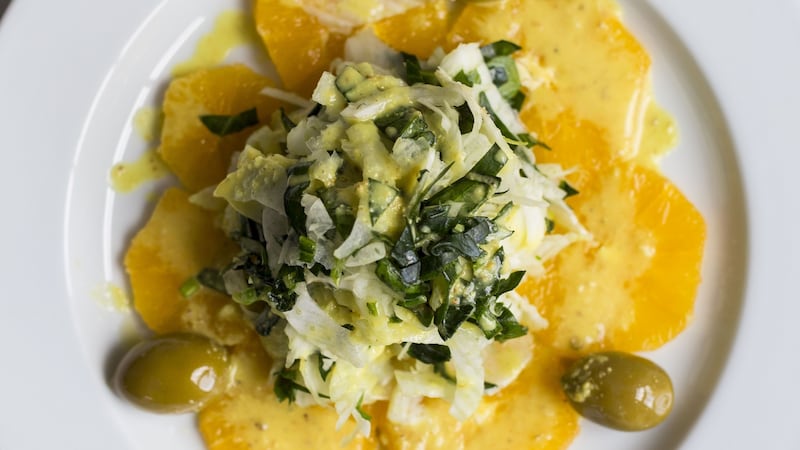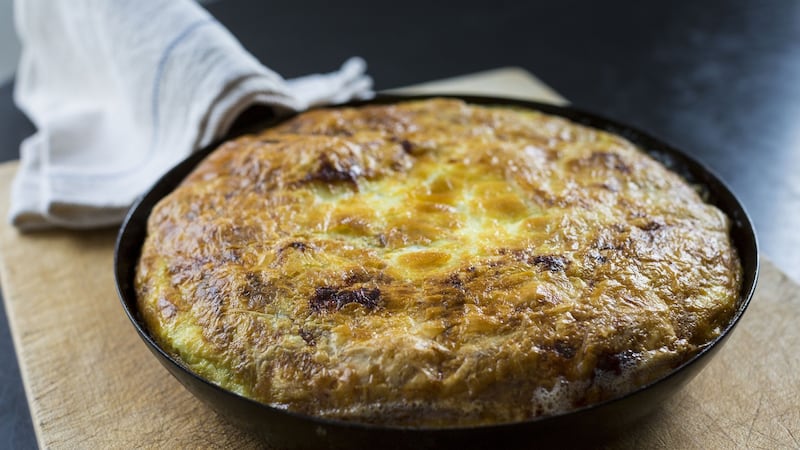This is the perfect week to start exploring the outdoors for ingredients to add to your diet.
I have just moved to the countryside and I am feeling blessed with the gift to reconnect with nature and to take advantage of what is in the hedgerows, ditches and on the shoreline. The evenings are longer giving us all a chance to get out and explore what is available to us, even if we only manage to get as far as the clothes line we can be surprised by a clump of just sprouted nettles, baby sorrel or the very unwanted dandelion.
For the next month, the countryside is a carpet of wild onion, often mistakenly referred to as wild garlic, due to its flavour. Wild garlic won’t show up until June and is not as readily available as wild onion. Wild onion looks similar to white bells and has a strong onion aroma. They are also known as Easter, three corner (as the leaves have three corners) or Trinity onion. These can be made into a pesto, soup or simply chopped and added to any salad.
This week as we unpacked the last few boxes in our new home, and the cupboard was bare except for a couple of avocados and a loaf of bread, I was pleasantly surprised when my daughter, Jill, produced a spring version of Guacamole on toast with olive oil, lemon juice and wild onion from outside the front door.
Less is so often more, and the joy of picking from the earth and eating with an appetite creates some of the best food memories.
Puy lentil salad with vegetable vinaigrette
Serves 4
This recipe make lentils an easy sell. Also, it gives the cook a chance to add in bits and pieces such as dandelion, sorrel or wild onion.
Ingredients
250g Puy lentils, washed
Handful of young dandelion leaves, washed and large ones, roughly chopped
2 tbsp carrots, finely chopped
2 tbsp red pepper, finely chopped
2 tbsp spring onion, finely chopped
2 garlic cloves, peeled and finely chopped
2 tbsp gherkins (use crisp cornichons), finely chopped
2 tbsp green olives, finely chopped
2 tsp capers, finely chopped
2 tbsp red wine vinegar
4-5 tbsp extra virgin olive oil
3 hard-boiled large eggs, sliced
2 heaped tbsp chopped flat-leaf parsley
Method
1 Cook the lentils in 500ml water until tender – about 15-20 mins.
2 Meanwhile, in a bowl, mix the rest of the ingredients together, except for the eggs and the parsley.
3 Drain the lentils and allow them to cool for a few minutes.
4 Tip the lentils into a bowl and add the vegetable mixture.
5 Stir together well, season generously and pile onto a serving dish.
6 Scatter each serving with the chopped eggs and parsley and eat warm or at room temperature.
Sea beet, fennel, orange and olive salad

Serves 4
We are in the last weeks of orange season, when they are juicy and sweet without any dryness. Fresh soft herbs are still scarce so adding some finely shredded sea beet adds colour, freshness and a great source of iron to this classic combination.
Ingredients
4 medium leaves of sea beet
1 large or two small heads of fennel
Juice of ½ lemon
2 oranges
16 olives of your choice
Dressing:
Zest from one orange, finely chopped
¼ cup orange juice
1 tsp honey
1 tsp balsamic vinegar
1 tsp Dijon mustard
1 tbsp olive oil
Salt and pepper to taste
Method
1 First, make the dressing by blending the zest, juice, honey, vinegar, mustard and olive oil until very smooth and well combined. Add salt and pepper and taste and blend again. Leave to rest for the flavours to develop while you prepare the rest of the ingredients.
2 Wash and remove the stalks of the sea beet, roll each leaf up tightly and shred finely.
3 Discard the outer leaves of the fennel if they are damaged and/or woody. Halve or quarter it and slice as thinly as possible, preferably on a mandolin. Leave to marinade in the lemon juice until you are ready to plate up the salad.
4 Prepare the oranges by removing the skin and pith with a sharp knife making sure you get all the pith as this is bitter to eat. Cut into rings.
5 When you are ready to eat, assemble the salad by scattering the fennel on a large serving plate, followed by the oranges and olives. Pour over the dressing and finish off by scattering with the chopped sea beet and the olives.
Nettle and potato gnocchi with sage, garlic and pine kernels

Serves 4
This is a dish that's about total comfort; potatoes, garlic, butter and pine nuts, perfect for a cool spring evening by the fire. I add in seaweed here for its health benefits and it's a perfect match for the potato and butter.
Ingredients
100g butter
3 cloves of garlic, sliced
1 tbsp pine kernels
15 sage leaves
Black pepper
3 tbsp grated Parmesan or Coolea cheese
For the gnocchi:
425g potatoes, unpeeled
75g nettle tops
1 tsp seaweed flakes
1 egg, beaten
200g plain flour, extra for rolling
½ tsp salt
Method
1 Put the potatoes on to steam (or simmer) in their skins for about 15 minutes. In the meantime, wearing gloves, wash the nettles well, removing any tough stalks. Then place them on top of the potatoes for their last few minutes of cooking.
2 Once they are wilted, remove and let them cool down. Then chop finely.
3 When the potatoes are cooked through, remove them to cool and dry out. When cool enough to handle, peel and mash them, making sure no lumps remain – if you have a ricer, use it.
4 Add the chopped nettles to the potatoes, along with the seaweed flakes.
5 When the mixture is cold, make a well in the middle and drop in the egg and sift over the flour and salt.
6 Gently bring everything together using your hands and knead to a soft dough. At this stage you may need a little more flour, both on the surface and in the mixture.
7 Roll the dough into long sausage shapes about 2.5cm in diameter, and cut into 2cm pieces. Dust lightly with flour and put on a tray. Refrigerate for 30 minutes.
8 After cooling, roll them into balls and then, taking a floured fork, push it into the dough to make a ridged surface. Return to the floured tray.
9 Bring a large pan of salted water to the boil and drop in about a third of the gnocchi. Simmer until they float to the surface, then give them a further 20-30 seconds. Lift out with a slotted spoon, drain well and place in a heated dish, along with a knob of butter. Keep warm, cooking the remaining gnocchi in two further batches.
10 In a pan, melt the butter with the garlic slices and pine kernels and cook until just golden. Remove them to a plate, then add the sage leaves to the butter, allowing them to froth and crisp up. Return the garlic and pine kernels to the pan, and spoon this buttery sauce over the gnocchi, grind over plenty of black pepper and dust with cheese.
11 Serve at once on hot plates as this is a dish, like pasta, I find gets cold quickly.
Creamy filo sea beet pie

The secret to filo pastry is not to worry about the look of the end result, as patching up never fails, and the filling and the cooking process act as a great camouflage for a few discrepancies.
I often use a mix of sea beet and nettles, and sometimes I add a bit of sorrel, which adds a lovely freshness to balance the richness of the cheese.
If you can’t get sea beet, replace it with spinach for this recipe; just steam it lightly to prepare.
Ingredients
1kg sea beet leaves
200g feta cheese, mashed with a fork
4 eggs
75g butter
500ml milk
350g large sheets of filo
200g Durrus or Gubbeen cheese, grated
Method
1 To make the filling, wash the sea beet, removing stems if they are thick and tough.
2 Bring a large pan of water to the boil and cook the sea beet in two batches, making sure you do not overcrowd the pan, as the leaves are inclined to turn a black colour. Give it a good stir as it boils to help prevent this from happening. Bring to the boil and simmer for a few minutes or until the leaves are just tender. Strain well. When cool enough to handle, squeeze them dry, pressing all the water out with your hands.
3 Mix the cooled sea beet into the mashed feta.
4 Beat the eggs in a large bowl.
5 Heat the butter in a pan. When it has melted, pour in the milk and heat until it is warm, then gradually beat this into the eggs.
6 Grease a rectangular or square baking dish that is a little smaller than the sheets of filo.
7 Open the filo sheets only when you are ready to use them and keep them covered so that they do not dry out.
8 Lay a sheet of filo in the greased baking dish, pressing it into the corners with a pastry brush and letting the edges come up the sides of the dish.
9 Pour a little of the milk, butter and egg mixture – about 80ml – all over the sheet. Sprinkle on a little of the grated cheese.
10 Lay a second sheet on top and repeat with the milk, butter and egg mixture and then the grated cheese. Continue until you have used half of the sheets, then spread the sea beet and feta filling evenly on top, covering the whole dish and using all the filling.
11 Finally, continue as before with the remaining filo, cheese and egg mixture until you have used it all up. Turn in the sides of the filo along with any over hanging pieces. Then pour over any remaining egg mixture.
12 Bake in the preheated oven for 30-40 minutes and until it's nicely golden on top and all the liquid is absorbed.











